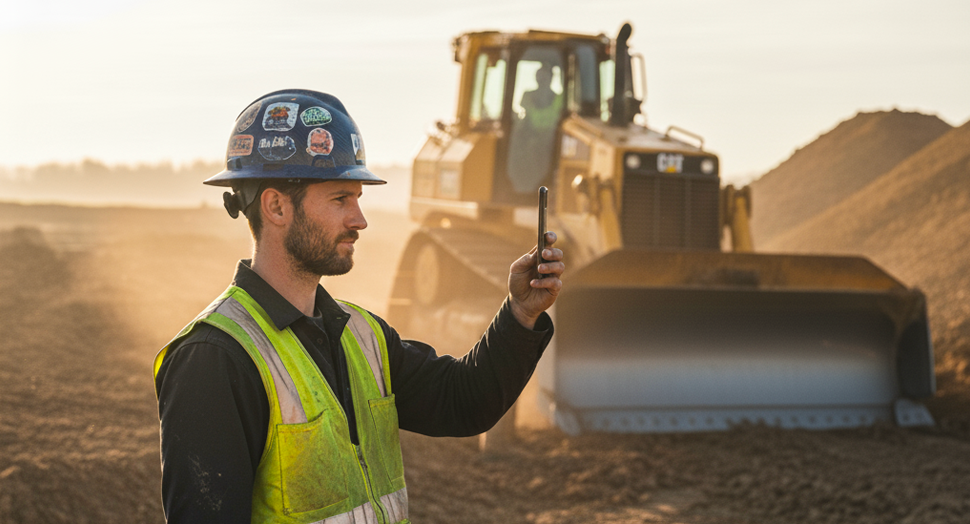
Most construction owners think employee social media is all risk with no value.
They’re completely wrong.
I’ve watched construction companies transform their biggest perceived liability into their most powerful marketing asset. The secret isn’t banning social media or pretending it doesn’t exist.
It’s building a framework that turns field workers into brand ambassadors.
The Hidden Marketing Goldmine
Ten field workers sharing their work on social media extends your company’s reach in ways traditional marketing never could. Their family, friends, and followers see authentic content that money can’t buy.
People are desensitized to corporate marketing speak. They have their guard up when something looks too polished.
Authentic content attracts people because it’s real. Construction companies achieving 5.02% engagement rates on Instagram understand this principle.
But here’s the strategic advantage most contractors miss: authentic exposure pre-qualifies the right audience.
In construction, you either build vertically or horizontally. When your heavy civil crew posts about bridge work, you attract people who want to work on infrastructure projects. When your commercial team shares high-rise progress, you connect with building-focused talent.
There’s no sense in spending time recruiting someone for heavy civil work if they want to build skyscrapers.
The Real Risks That Matter
Employee poaching isn’t the threat contractors think it is. Your competitors already know who’s on your team. Recruiters have multiple ways to find and contact your employees.
Spotlighting team members on social media actually makes them more likely to stay than leave because they feel appreciated.
The real risks are different. Two concerns keep me focused: sharing project information that clients want to remain confidential, and safety violations that become public liability.
Field workers often develop workarounds that they don’t consider safety issues. They’re accustomed to seeing these practices and don’t consider how they appear to outsiders.
When someone posts content that violates an NDA or showcases unsafe practices, they’re not thinking like business owners. They’re sharing their day.
These risks can kill companies. But they’re manageable with the right approach.
Building Your Framework
I pair a Toolbox Talk with comprehensive social media education. You’re meeting field workers where they already get safety information.
Field workers should ask their PM or superintendent before posting about specific projects. Marketing teams can maintain approved project lists for easy reference.
For safety concerns, establish clear review channels through safety, marketing, or direct supervision.
But here’s the key: you can’t expect workers to run every photo by management before posting. That’s not realistic when someone wants to share something impressive they just built.
Create internal filters instead. Remind them to double-check photos for safety concerns before posting. When they tag the company, marketing and safety get alerted to provide a second set of eyes review.
Critical insight: Marketing teams need safety training even if they never visit jobsites (which they should). You can’t be the last line of defense if you don’t know what to look for.
Implementation That Actually Works
Give your team frameworks instead of rules. Rules create compliance robots or an attitude that it’s safer not to participate. Frameworks create brand ambassadors.
Encourage employees to share and comment on company posts. Support their own content creation. Many larger construction companies run formal Employee Generated Content (EGC) programs with posting incentives.
For smaller contractors, start simple. Have workers email photos and descriptions to social@yourcompany.com. Make this an alias for marketing and safety review.
Field employees don’t need to track which marketer handles social media. The system works regardless of staff changes.
The most important policy element: Let your company’s core values guide decision-making. Instead of lengthy do-and-don’ts, anchor everything back to your fundamental principles.
This makes choices intuitive rather than bureaucratic.
Measuring What Matters
Tracking social media ROI is challenging because individual posts do not directly generate sales or recruit employees. B2B prospects typically require 10-25 touchpoints before making a purchase.
I recommend avoiding dollar-amount attribution to social media. Focus on social media as a mechanism for building momentum, controlling your message, and sharing thought leadership.
For CFOs demanding ROI justification, emphasize the importance of social media for talent acquisition. Recruitingcosts can easily run $15,000-20,000 for each field worker.
Social media programs cost a fraction of traditional recruiting fees. Even modest success pays for itself quickly.
Beyond generating revenue and attracting employees, employee social media builds engagement that accelerates deals.
The Consistency Factor
The difference between successful implementation and failure comes down to consistency and leadership engagement.
You can’t do social media for a month, stop for weeks, then restart. I’ve seen contractors build engaged audiences with dedicated social media managers, then fail to backfill when that person leaves.
Six months later, they have sales pipeline problems.
When leadership visibly supports and participates, it signals this isn’t another initiative that will fade away.
The silence problem: Not doing social media sends messages to prospective clients and potential employees, too. People want authenticity, transparency, and connection.
In an industry where trust and capability are paramount, being invisible online becomes a significant competitive disadvantage.
Kickstart Your Construction Social Media Framework
Start with education. Conduct Toolbox Talks to explain the social media opportunities and risks.
Establish your social@company.com system for content review, and train your marketing team on the basics of safety.
Develop your framework based on company values rather than exhaustive rule lists.
Most importantly, commit to consistency. Social media is infrastructure, not a campaign.
Your field workers are already posting about their work. The question isn’t whether employee social media will happen. The question is whether you’ll harness it strategically or let it remain a missed opportunity.
Transform your biggest perceived liability into your most authentic marketing asset. Your competition is probably still trying to ban it completely.
That’s your advantage.
